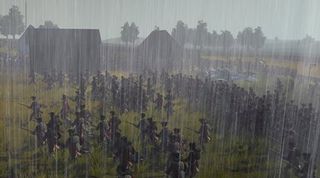Empire: Total War – hands-on
Strategy gaming's most epic franchise expands to encompass sea warfare
Repeating History
A historical game requires historical research, both for factual elements and for inspiration. Creative Assembly tends to divvy up research duties based on team interests: Designer Jamie Ferguson has pored over sailing books and stories of life aboard ship. Lead Designer James Russell favors tomes detailing the grand political and social forces of the age, and what actually pushed the European powers overseas: the driving economic forces of colonization and the rivalry between the great powers.

They’re aware this lends their games an educational aspect, even though that has not been a core aim. “You can get people into something they wouldn’t necessarily get into otherwise,” says Ferguson. “They may not want to pick up a book. They may find that a dry medium. But games can be a learning experience without being a lesson. We don’t teach history...”
“...but people learn from the game,” interrupts Russell. “One of our sources of pride is when a forum-ite says the only reason they went onto university is that they learned about a piece of history and it excited their interest. Games should be a positive experience, as well as a pastime.”
Oh, brave new world map
Of all the things to get obsessed about, the world map is probably the shallowest. But, while the designers are extolling the promises of the democracy system and ship-based trade, we find ourselves preoccupied by the startlingly realistic seas. Given that they look like video footage of the open water, the word “photorealistic” may even be justified. “We wanted to try to create a world that seemed more real, and didn’t feel like playing a game of Risk,” says Designer Jamie Ferguson. Based on NASA data, the map gives more the impression of looking at a world, rather than a map of one - something the team has pursued vigorously. “You really get the feeling you’re looking at the Earth from great height,” says Lead Designer James Russell.

This influenced other decisions, too, such as showing economic resources outside cities on the map, rather than hidden inside the cities themselves; the result is transparency of information. Having a world that’s recognizable at a glance rather than an abstracted representation helps to orient players as they navigate in a sea of data. “You don’t have the issue of, ‘What’s that blue thing over there? Oh, that’s the sea,’” says Ferguson. “You can see that it’s the sea. You can see that this is the forest.”
Campaign troubles
Modern RTS games have trended away from a linear chain of missions and toward non-linear campaign maps. While that structure has appeal, it’s never quite worked - there’s a sense that the campaigns are artificial, that the macro-level of battle doesn’t mean anything because the game’s real economics are there on the battlefield.

In Total War, this works differently, and potentially brilliantly. Here, the economics of the battlefield are those of fatigue and morale. “Keeping that campaign level apart allows that to come through, because the player isn’t worrying about going off to chop wood,” says Designer Jamie Ferguson. “Napoleon didn’t spend one second thinking about woodcutters during the battle of Waterloo. Our games are about being Julius Caesar, being Wellington, Marlborough, Prince Eugenius, or any one of those great commanders... but at the same time, being Peter the Great, or Julius Caesar, the dictator administrating Rome.”
Sign up to the GamesRadar+ Newsletter
Weekly digests, tales from the communities you love, and more

“They’re considering very different things, whether they’re on the empire level or the battlefield,” adds James Russell, “It’s a completely different mind-set, and that’s where the separation comes. When [Napoleon] was back in Paris, he was thinking about ‘Do I decimalize? Do I introduce the meter?’” says Jamie. “I think that’s the thing players of other games don’t get - the change of pace that allows you to have that intense moment with everything that goes into it, and when you step back out of that, you then concentrate on trying to achieve greater things.”
Sep 24, 2008

Helldivers 2 dev asks players to stop deliberately shooting at soldiers with that sweet blue pre-order bonus armor that's apparently a yogurt salesman uniform

Stellar Blade release time – the countdown to the new PS5 action RPG is on

Wilson Fisk celebrates 60 years of Daredevil by reclaiming his mantle as the Kingpin
Most Popular


